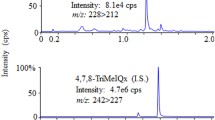Abstract
Heterocyclic aromatic amines (HAAs) formed in cooked muscle foods are recognized as mutagenic and carcinogenic compounds. A total of 9 nine HAAs were analyzed in 34 meat products consumed in China. The total HAAs content in all meat products ranged from 4.14 to 108.80 ng/g. Dry and sauced meats contained higher concentration of total HAAs than other kinds of meat products. Samples from East and Northwest China showed higher concentrations of total HAAs than samples from other regions. The most common specific HAAs, harman and norharman, were detected in all meat samples at levels of 1.09–63.97 and 1.19–62.30 ng/g, respectively. Concentrations of MeIQx, PhIP, 4, 8-DiMeIQx, and AαC were much lower. MeAαC (n=8), IQ (n=15), and Trp-P-2 (n=23) were detected in some samples.
Similar content being viewed by others
References
Sugimura T. Nutrition and dietary carcinogens. Carcinogenesis 21: 387–395 (2000)
IARC. Monographs of Evaluation of the Carcinogenic Risk of Chemicals to Human. International Agency for Research on Cancer, Lyon, France (1993)
Totsuka Y, Takamura-Enya T, Nishigaki R, Sugimura T, Wakabayashi K. Mutagens formed from β-carbolines with aromatic amines. J. Chromatogr. B 802: 135–141 (2004)
Bordas M, Moyano E, Puignou L, Galceran MT. Formation and stability of heterocyclic amines in a meat flavour model system. J. Chromatogr. B 802: 11–17 (2004)
Oz F, Kaban G, Kaya M. Effects of cooking methods on the formation of heterocyclic aromatic amines of two different species of trout. Food Chem. 10: 67–72 (2007)
Margit DA, Lene DO, Kirsten J, Lene M. Content of heterocyclic amines and polycyclic aromatic hydrocarbons in pork, beef, and chicken barbecued at home by Danish consumers. Meat Sci. 93: 85–91 (2013)
Busquets R, Bordas M, Toribio F, Puignou L, Galceran MT. Occurrence of heterocyclic of heterocyclic amines in several homecooked meat dishes of the Spanish diet. J. Chromatogr. B 802: 79–86 (2004)
Back YM, Lee JH, Shin HS, Lee KG. Analysis of heterocyclic amines and β-carbolines by liquid chromatography-mass spectrometry in cooked meats commonly consumed in Korea. Food Addit. Contam. 26: 298–305 (2009)
Oz F. Quantitation of heterocyclic aromatic amines in ready to eat meatballs by ultra fast liquid chromatography. Food Chem. 126: 2010–2016 (2011)
Gross GA, Grüter A. Quantitation of mutagenic/carcinogenic heterocyclic aromatic amines in food products. J. Chromatogr. A 592: 271–278 (1992)
Oz F, Kaban G, Kaya M. Effects of cooking methods and levels on formation of heterocyclic aromatic amines in chicken and fish with Oasis extraction method. LWT-Food Sci. Technol. 43: 1345–1350 (2010)
Knize MG, Dolbare F, Carrol K, Moore D, Felton JS. Effect of cooking time and temperature on the heterocyclic amine content of fried beef patties. Food Chem. Toxicol. 32: 595–603 (1994)
Liao GZ, Xu XL, Zhou GH. Effects of cooked temperatures and addition of antioxidants on formation of heterocyclic aromatic amines in pork floss. J. Food Process. Pres. 33: 159–175 (2009)
Skog KI, Johansson MAE, Jägerstad M. Carcinogenic heterocyclic amines in model systems and cooked foods: A review on formation, occurrence, and intake. Food Chem. Toxicol. 36: 879–896 (1998)
Johansson M, Jägerstad M. Occurrence of mutagenic/carcinogenic heterocyclic amines in meat and fish products, including pan residues, prepared under domestic conditions. Carcinogenesis 15: 1511–1518 (1994)
Lan CM, Chen BH. Effects of soy sauce and sugar on the formation of heterocyclic amines in marinated foods. Food Chem. Toxicol. 40: 989–1000 (2002)
Sun L, Zhang F, Yong W, Chen S, Yang ML, Ling Y, Chu XG, Lin JM. Potential sources of carcinogenic heterocyclic amines in Chinese mutton shashlik. Food Chem. 123: 647–652 (2010)
Abdulkarim BG, Smith JS. Heterocyclic amines in fresh and processed meat products. J. Agr. Food Chem. 46: 4680–4687 (1998)
Zimmerli B, Rhyn P, Zoller O, Schlatter J. Occurrence of heterocyclic aromatic amines in the Swiss diet: analytical method, exposure estimation, and risk assessment. Food Addit. Contam. 18: 533–551 (2001)
Oz F, Kaya M. The inhibitory effect of red pepper on heterocyclic aromatic amines in fried beef Longissimus dorsi muscle. J. Food Process. Pres. 35: 806–812 (2011)
Louis ED, Zheng W, Jiang W, Bogen KT, Keating GA. Quantification of the neurotoxic-carboline harmane in barbecued/grilled meat samples and correlation with level of doneness. J. Toxicol. Env. Heal. A 70: 1014–1019 (2007)
Liao GZ, Wang GY, Zhang YJ, Xu XL, Zhou GH. Formation of heterocyclic amines during cooking of duck meat. Food Addit. Contam. A 1668–1678 (2012)
Khan MR, Bertus LM, Busquets R, Puignou L. Mutagenic heterocyclic amine content in thermally processed offal products. Food Chem. 112: 838–843 (2009)
Kizil M, Oz F, Besler HT. A review on the formation of carcinogenic/mutagenic heterocyclic aromatic amines. J. Food Process. Technol. 2: 160–166 (2011)
Arvidsson P, van Boekel MAJS, Skog K, Solyakov A, Jägerstad M. Formation of heterocyclic amines in a meat juice model system. J. Food Sci. 64: 216–221 (1999)
Pais P, Knize MG. Chromatographic and related techniques for the determination of aromatic heterocyclic amines in foods. J. Chromatogr. B 747: 139–169 (2000)
Turesky RJ, Taylor J, Schnackenberg L, Freeman JP, Holland RD. Quantitation of carcinogenic heterocyclic aromatic amines and detection of novel heterocyclic aromatic amines in cooked meats and grill scrapings by HPLC/ESI-MS. J. Agr. Food Chem. 53: 3248–3258 (2005)
Dong A, Lee J, Shin HS. Formation of amino-imidazo-azaarenes and carbolines in fried beef patties and chicken breasts under different cooking conditions in Korea. Food Sci. Biotechnol. 20: 735–741 (2011)
Herraiz T. Relative exposure to -carbolines norharman and harman from foods and tobacco smoke. Food Addit. Contam. 21: 1041–1050 (2004)
Ahn J, Grun IU. Heterocyclic amines: Inhibitory effects of natural extracts on the formation of polar and nonpolar heterocyclic amines in cooked beef. J. Food Sci. 70: 263–268 (2006)
Author information
Authors and Affiliations
Corresponding author
Rights and permissions
About this article
Cite this article
Pan, H., Wang, Z., Guo, H. et al. Heterocyclic aromatic amines in meat products consumed in China. Food Sci Biotechnol 23, 2089–2095 (2014). https://doi.org/10.1007/s10068-014-0284-0
Received:
Revised:
Accepted:
Published:
Issue Date:
DOI: https://doi.org/10.1007/s10068-014-0284-0




